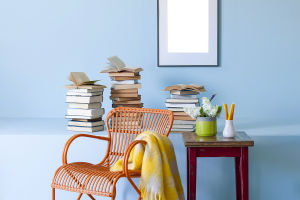Creating the perfect study or home office is something that many of us aspire to, especially if we value a peaceful environment where we can learn and work efficiently.
A well-designed space can encourage productivity and help us relax when needed. Today, let's dive into the essential principles and tips for decorating your study room.
1. Create a Quiet Atmosphere
The first step in designing a great study is ensuring it's a peaceful space where distractions are minimized. We should opt for materials that help absorb sound for both the walls and floors. Carpet is a great option, but avoid anything too thick or plush, as it might make us feel lazy. A thinner rug is more ideal, as it helps maintain focus.
Lighting is just as important. A well-lit room not only protects our eyesight but also sets the right mood for study. We recommend using a combination of daylight bulbs and incandescent lights. Adding a desk lamp can give you extra, flexible lighting. Just make sure the light is soft and gentle, not harsh, to avoid straining your eyes.
2. Proper Lighting
The right lighting is essential for reading and writing. Bright lights can strain our eyes, while dim lighting can leave us feeling tired. The best setup is to place your desk near a window with plenty of natural light, but avoid direct sunlight to prevent glare.
Having a table lamp and some spotlights on bookshelves also enhances the reading experience. Position the lamp so that it illuminates the workspace evenly. Also, avoid placing it too close to your eyes to prevent the light from being too intense.
3. Choosing the Right Colors
The color scheme in your study room plays a major role in setting the tone. The right hues can make a space feel calm and conducive to focus. Typically, cooler tones like blue, white, or light gray are great choices for a study room. They help calm the mind and improve concentration.
Avoid warm colors, which can be too stimulating and may distract you from your work. Ultimately, pick a color that suits your personal taste, but try to stick to cooler shades to maintain a productive atmosphere.
4. Bookshelves
What's a study room without a bookshelf? It's essential for both storage and organization. When choosing or designing a bookshelf, think about its functionality and style. It should not only be sturdy but also easy to access. Keep the height reasonable so that you don't have to stretch too much to grab your books.
Place the bookshelf against a wall to save space. Additionally, try to maintain a consistent color scheme with your desk and chairs for a cohesive look.
When arranging books on your shelves, it's best to place heavier, thicker books at the bottom to avoid damaging the shelves. Always aim for a balanced look—avoid the "top-heavy" design that could lead to the bookshelf toppling if bumped.
5. Air Conditioning
Air conditioning can be a game-changer in the study room. It's especially important for maintaining the right level of humidity to prevent your books from getting damp and yellowing. When the weather is humid, set your air conditioner to dehumidify the room.
For larger rooms, a floor-standing air conditioner is ideal. For smaller spaces, a wall-mounted unit will suffice. Avoid using fans as they can create noise, which is a distraction in an otherwise quiet environment.
6. Curtains
While privacy in a study room isn't as crucial as in other rooms, curtains are still necessary. Opt for sheer, light-colored curtains that let in some natural light while blocking out glare. This creates a calm and soothing atmosphere. Lighter colors like pastel blues or greens are perfect for reducing eye strain. If you prefer, you can also install Venetian blinds for better light control and a more modern look.
7. Greenery
Adding a few plants to your study room is a great way to improve the atmosphere. Plants not only add a touch of nature but also help alleviate eye strain, especially after long reading or working sessions. A small potted plant on your desk can freshen up the space and provide a calming effect. If you love flowers, consider a vase of fresh blooms to add a pleasant fragrance to the air.
8. A Comfortable Sofa
A sofa in your study room can make a huge difference when you need to take a break. After long hours of reading or working, lying on a comfortable sofa can help you recharge. It's also perfect for casual meetings with friends or colleagues. Just make sure to place the sofa in a corner of the room, ideally not facing the door. This ensures that you feel more relaxed and less exposed to outside distractions during important discussions.
Maintaining a clean and organized study room is key to staying focused. Regularly cleaning the space and keeping it tidy will enhance your productivity. When choosing cleaning tools, make sure to keep them exclusive to the study room—avoid using kitchen or bathroom items to prevent oil or dirt from transferring to your study area. A well-kept environment will make your study room a peaceful sanctuary for learning and working.
Lykkers, what do you think? Have you already started designing your perfect study space? Let us know in the comments!


